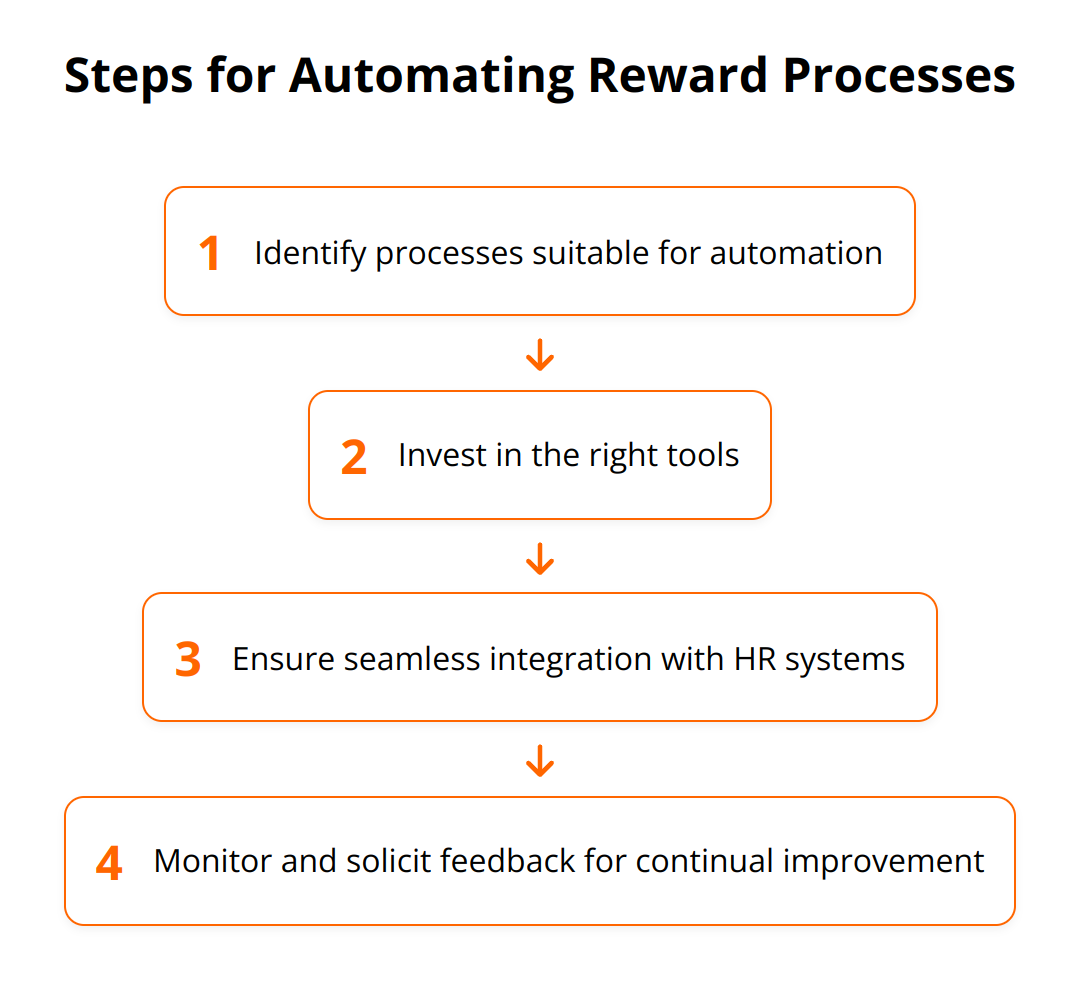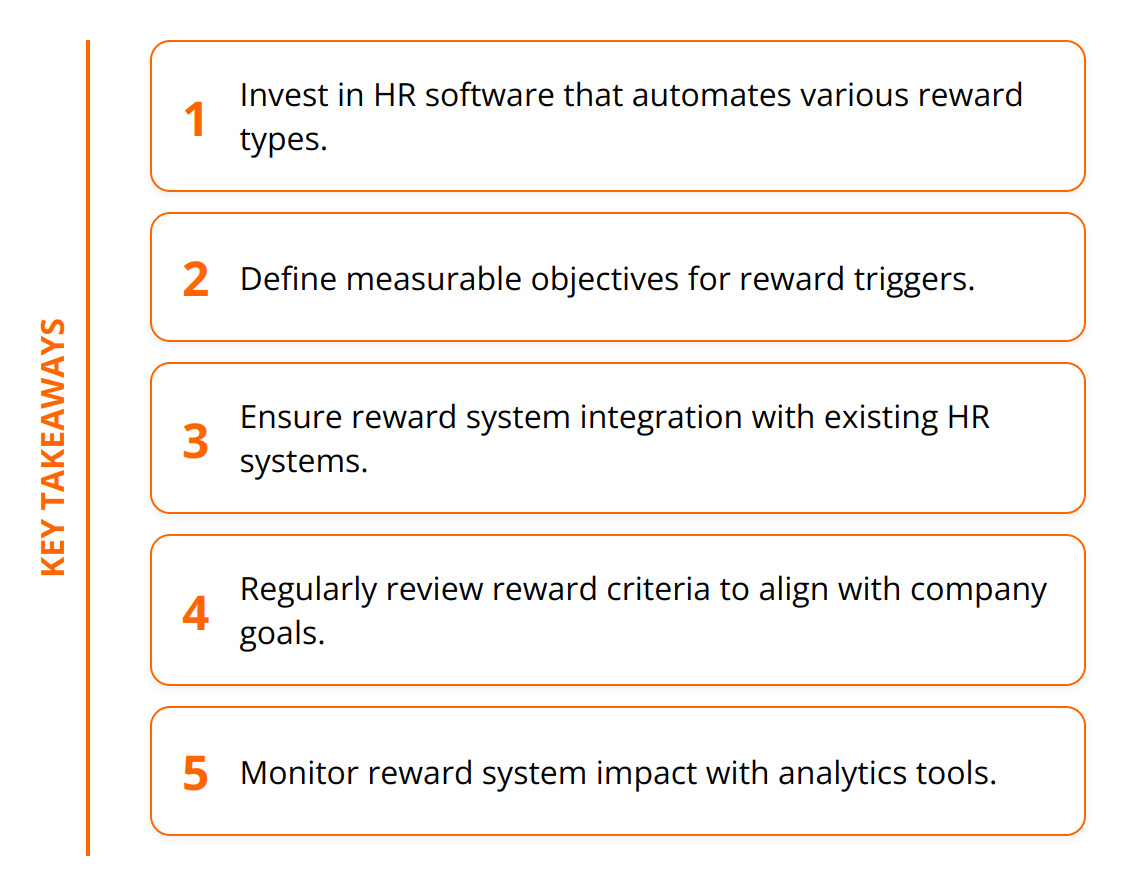
At Reward the World, we understand the pivotal role that efficient reward mechanisms play in motivating and retaining top talent. Automation presents a brilliant opportunity to enhance these systems for better performance and satisfaction. This post “How to Automate Your Reward Mechanisms for Efficiency” will guide you through automating your reward mechanisms from understanding the basics to implementing best practices. Join us as we navigate the journey towards a more efficient and effective reward strategy.
Automating Reward Mechanisms
Reward mechanisms are essential for acknowledging employees’ efforts and achievements, fostering a productive and motivated workplace. These mechanisms can include anything from financial bonuses to public recognition and benefits like extra vacation days. However, managing these rewards manually can be time-consuming and error-prone. Automation of these processes not only saves time but also ensures fairness and transparency in distributing rewards.

Importance of Efficient Reward Systems
Efficient reward systems directly impact an organization’s success by enhancing employee satisfaction and retention. An effective system recognizes and rewards employees promptly and fairly, which in turn boosts their motivation and loyalty towards the organization. Automating these mechanisms enables organizations to implement these practices seamlessly, ensuring no deserving employee is overlooked.
Embracing Automation for Rewards
The leap towards automating reward systems requires an understanding of the various types of rewards and the impact automation has on these mechanisms. Broadly, rewards can be categorized into monetary, recognition, and benefits. Each type appeals to different motivational triggers in employees and thus should be tailored to fit the diverse workforce.
- Monetary Rewards: These include bonuses, pay raises, and other financial incentives. Automation can ensure timely and accurate distribution based on predefined criteria or achievements.
- Recognition: Public acknowledgment or awards for individual or team accomplishments. Automated systems can track milestones and trigger recognition protocols, making sure efforts are acknowledged without delay.
- Benefits: These could range from health insurance upgrades to extra vacation days. Automating these rewards means employees can easily access and utilize their benefits without bureaucratic delays.

The introduction of automation in reward mechanisms presents several advantages. It reduces manual workload, minimizes the risk of human error, and provides a clear, unbiased system for rewarding employees. Moreover, automated systems can collect and analyze data on reward programs’ effectiveness, providing valuable insights for further improvement.
Practical Steps to Automate Your Rewards
- Select the Right Tools: Invest in comprehensive HR software that supports automation for various types of rewards.
- Set Clear Criteria: Define clear, measurable objectives that trigger the different rewards. This ensures transparency and fairness in the distribution of rewards.
- Communicate: Make sure employees understand how the reward system works. This helps in setting the right expectations and enhances the overall transparency of the process.
- Monitor and Adjust: Keep an eye on the system’s effectiveness and be ready to make adjustments. Continuous improvement is key to an efficient reward mechanism.
For detailed strategies on scaling your reward program, explore our guide on scaling your reward program.
By harnessing the power of automation, companies can ensure their reward mechanisms are as efficient and effective as possible. This not only enhances employee satisfaction but also contributes significantly to the organization’s success. Remember, the goal of automation should be to support and enhance the existing reward strategy, making it more impactful for every employee.
Automating Reward Processes
Transitioning to an automated reward mechanism demands a well-thought-out plan and the selection of robust tools to ensure success. It’s about identifying which reward processes can be automated, choosing the right tools, and effectively integrating these solutions within your existing HR systems. Let’s dive into actionable insights and steps to ensure a seamless transition.
Identifying Processes Suitable for Automation
Start by pinpointing the reward mechanisms that consume significant time or are prone to error in manual settings. Typically, processes like tracking employee achievements, calculating bonuses, distributing non-monetary rewards, and updating benefit allocations are ripe for automation. Automating these processes frees up HR personnel to focus on more strategic tasks like employee engagement and talent management.
The Quest for the Right Tools
Investing in the right tools is paramount. The ideal HR software should offer flexibility to cater to your specific reward needs, be it monetary, recognition, or benefits. Look for platforms that provide customizable criteria-setting options and real-time tracking capabilities. Tools that offer analytics and reporting features are invaluable, as they allow you to measure the effectiveness of your reward system and make data-driven adjustments.
For those seeking software that offers comprehensive features tailored for employee recognition schemes, exploring options like employee rewards platforms can provide valuable ideas. Such platforms often come with built-in automation capabilities, making them a good starting point.
Seamless Integration with HR Systems
The success of automating your reward mechanism largely depends on its integration with existing HR systems. Seamless integration ensures that data flows freely between systems, reducing errors and ensuring that rewards are distributed accurately and timely. When evaluating tools, prioritize those that offer easy integration capabilities with your current setup.
Consider the following practical tips to smooth the transition:
- Consult HR and IT teams during the selection process to ensure the chosen tool meets both functional and technical requirements.
- Test integration before full-scale implementation to address any potential issues.
- Train your staff on the new system to ensure they are comfortable with the automated processes.
- Monitor and solicit feedback regularly to identify areas for improvement.
By automating reward mechanisms, companies not only enhance operational efficiency but also ensure fairness and transparency in their reward distribution. The steps outlined above serve as a roadmap for organizations looking to modernize their reward systems.
Remember, the automation of reward mechanisms is not just about implementing new software. It’s about enhancing employee satisfaction and driving organizational success. The end goal is to have a system that recognizes and rewards employees promptly and accurately, fostering a motivated and loyal workforce. As we continue to refine our reward systems, staying attuned to emerging trends in HR technology will keep your organization competitive and adaptive to the changing landscape of employee engagement and recognition.

Maintaining Automated Reward Systems
Effective reward systems are the backbone of employee satisfaction and retention. However, successfully automating these systems requires ongoing attention and fine-tuning. Businesses must adapt to changes in workforce dynamics, technological advancements, and company goals. This part of our guide focuses on practical advice for maintaining an advanced automated reward system.
Keep Criteria and Rewards Up-to-Date
The business world doesn’t stand still, and neither should your reward criteria. Regular reviews of what triggers rewards ensure your system remains aligned with current company objectives and market conditions. For instance, if your company is pushing for digital transformation, consider rewarding employees who are leading these efforts or acquiring new digital skills.
Ensuring Fairness and Transparency
A core benefit of automated systems is their ability to administer rewards without bias. However, fairness extends beyond the software itself. It involves clear communication about how the system works and how employees can achieve rewards. An open-door policy for concerns about the system’s fairness is essential, as well as regular audits to ensure rewards are distributed as intended.
The Importance of Monitoring and Analysis
Data is a powerful tool that, if used correctly, can continually enhance the effectiveness of your reward system. By monitoring engagement levels, turnover rates, and employee feedback, you can assess the impact of your automated rewards. Adjustments based on this data can improve employee morale and performance. For deeper insights, consider employing advanced analytics to understand trends and patterns in reward system effectiveness.

Practical Steps for Success
- Schedule regular reviews of reward criteria and make adjustments as necessary.
- Use employee surveys to gauge the perceived fairness and transparency of the reward system.
- Employ analytics tools to measure the impact of your reward system on employee performance and satisfaction.
- Be proactive in addressing any concerns regarding fairness or system errors.
By keeping these factors in mind, you can ensure your automated reward system remains a dynamic and integral part of your organization’s success. Maintaining an efficient, fair, and responsive system not only boosts morale but also enhances overall company performance.
Wrapping Up
Automating reward mechanisms offers a wealth of benefits, transforming how organizations recognize and incentivize their workforce. From enhancing efficiency and effectiveness to ensuring fairness and transparency, the advantages are clear. Automation enables timely recognition, reduces the risk of human error, and provides insightful data for continuous improvement. Moreover, it personalizes the reward experience, ensuring that each achievement gets the acknowledgment it deserves.

Embracing automation is not merely about keeping up with technological advancements; it’s about valuing your team’s effort in the most impactful way. By ensuring rewards are timely, fair, and aligned with company goals, you not only boost morale but also foster a culture of achievement and recognition. This culture, in turn, drives better performance and loyalty among employees, contributing to the overall success of the organization.
The journey towards automating your reward system is an ongoing one, characterized by constant learning, adaptation, and innovation. As your organization evolves, so too should your reward mechanisms. Regular reviews, coupled with feedback from your team, will ensure your system remains relevant and effective. Leveraging data analytics further enriches this process, offering deep insights into what works and what can be improved.
At Reward the World, we understand the significance of continuous improvement in maintaining a successful automated reward system. Our platform, available in 15 languages and serving a massive 250 million users, is designed to support organizations in their quest to enhance employee recognition and customer loyalty. With our instant reward delivery, GDPR compliance, and robust analytics, we offer an efficient, effective solution to elevate your reward strategy.
We encourage businesses to leverage the power of automation to not only streamline their reward mechanisms but also to embrace a culture of recognition that resonates across the entire organization. Remember, your people are your greatest asset, and recognizing their contributions is key to fostering a motivated, loyal, and high-performing team.
For more insights on perfecting your reward strategy with our turnkey solutions, explore Reward the World.
In conclusion, automating your reward mechanisms presents a golden opportunity to enhance organizational efficiency and employee satisfaction. With the right tools and a commitment to continual improvement and innovation, your automated reward system will serve as a cornerstone of your organization’s success.
We hope this “How to Automate Your Reward Mechanisms for Efficiency” has provided you a good summary of the benefits and challenges of such a project.

